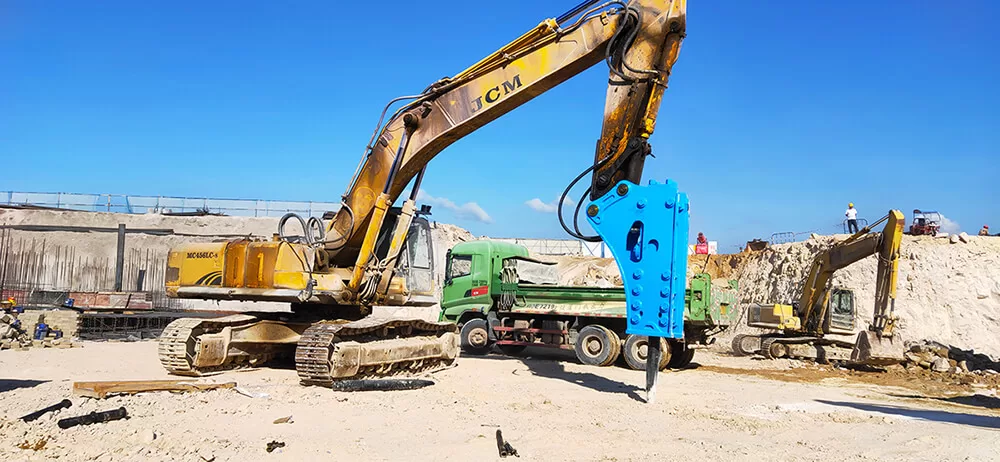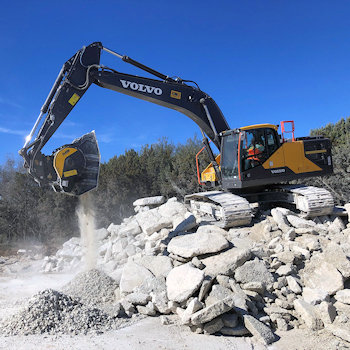Excavator Rock Arm and Breaker Comparing Working Conditions
Excavators are versatile machines used in various construction and demolition projects, offering a wide range of attachments to meet specific job requirements. Two such attachments, the excavator rock arm and excavator breaker, serve different purposes and excel in distinct working conditions. In this article, we will compare the working conditions suitable for these attachments to help contractors and operators make informed decisions.

Excavator Rock Arm
Excavator rock arms, also known as rock grapples or rock grabs, are powerful tools designed for handling and moving large rocks, boulders, and debris. They are typically attached to the excavator’s arm and offer a sturdy grip to lift and transport heavy materials. Excavator rock arm are highly effective in specific working conditions.
-
Rock Excavation and Quarrying:
Excavator rock arms are ideal for working in rocky terrains and quarries. They can easily grip, lift, and transport large rocks, making them essential for quarrying operations. The robust design and powerful grip make them well-suited to handle even the heaviest of stones.
-
Site Clearance:
In construction projects where clearing a site involves removing large rocks, boulders, and debris, excavator rock arms are indispensable. They can clear the area quickly and efficiently, making way for other construction activities.
-
Landscaping and Earthmoving:
For landscaping projects that involve moving and positioning rocks for decorative purposes or to create retaining walls, excavator rock arms provide precision and control. They enable operators to place rocks with accuracy and finesse.
-
Environmental Restoration:
Excavator rock arm are also used in environmental restoration projects to relocate large rocks and restore natural landscapes. Their ability to handle heavy materials makes them valuable in preserving and rehabilitating ecosystems.
Excavator Breakers
Excavator breakers, also known as hydraulic hammers, serve a different purpose and excel in distinct working conditions. These powerful attachments are designed for breaking and demolishing hard materials, such as concrete, asphalt, and rock.

-
Demolition and Concrete Removal:
Excavator breakers are essential in demolition projects, especially in urban environments where controlled demolition is necessary. They can efficiently break down concrete structures, foundations, and pavement without causing excessive collateral damage.
-
Road Construction and Maintenance:
For road construction and maintenance, excavator breakers are used to remove existing asphalt or concrete surfaces. Their precision and power make them an excellent choice for creating smooth roadbeds.
-
Utility Trenching:
When trenching for utilities like water pipes and electrical cables, excavator breakers are used to break through compacted soil and rocks efficiently. This is crucial in utility installation and maintenance.
-
Excavation in Hard Soil and Rock:
In excavation projects where the terrain is challenging, including rocky soils, excavator breakers can be used to create trenches or dig through hard materials. They offer the advantage of reduced wear and tear on the excavator compared to traditional digging methods.
Comparison of Working Conditions
-
Material Type:
The primary factor that distinguishes the working conditions of excavator rock arms and excavator breakers is the type of material they handle. Rock arms are designed for handling and transporting heavy rocks and debris, while breakers are specialized for breaking hard materials like concrete and rock.
-
Precision vs. Power:
Excavator rock arms offer precision and control, making them suitable for delicate tasks such as landscaping and environmental restoration. In contrast, excavator breakers are all about power and efficiency, making them indispensable for heavy demolition and excavation tasks.
-
Environmental Impact:
The choice between these attachments can significantly impact the environment. Excavator rock arms are more environmentally friendly, as they allow for the relocation and preservation of natural elements, while excavator breakers generate considerable noise and dust in demolition operations.
-
Equipment Maintenance:
Excavator breakers may cause more wear and tear on the excavator due to their powerful impacts. Frequent maintenance and replacement of breaker parts may be necessary. Excavator rock arms, on the other hand, have less impact on the excavator’s maintenance needs.
-
Versatility:
Excavator rock arm can handle a broader range of materials and working conditions, while excavator breakers are specialized for hard material demolition and excavation. Operators may choose rock arms if they require versatility in their projects.
Conclusion
Excavator rock arm and excavator breakers are two valuable attachments for excavators, each excelling in specific working conditions. The choice between these attachments should be based on the nature of the project and the materials to be handled. Excavator rock arms are ideal for precision tasks like rock handling and landscaping, while excavator breakers are essential for demolition and excavation in hard materials. Understanding the differences and choosing the right attachment is crucial for maximizing efficiency and productivity in construction and excavation projects.


